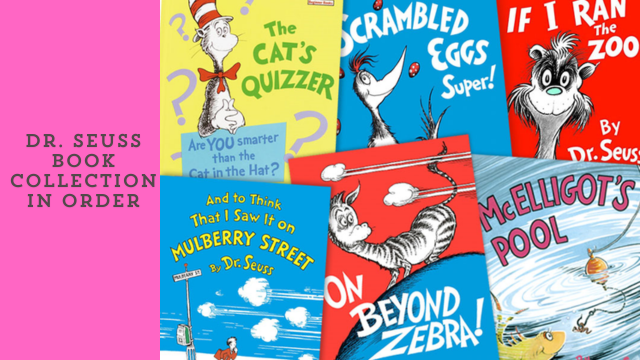Dr. Seuss Book Collection in Order: A Comprehensive Guide
The works of Theodor Seuss Geisel, known to the world as Dr. Seuss, have captivated readers for decades. His unique blend of whimsical characters, engaging rhymes, and imaginative worlds have made his books staples in children’s literature. While often light-hearted and entertaining, Dr. Seuss’ stories carry profound moral lessons that continue to resonate with readers of all ages. For those looking to explore his works in a systematic manner, understanding the Dr. Seuss book collection in order can be immensely helpful. This blog post provides a chronological guide to his books, giving insight into the themes, styles, and messages that evolved throughout his career.
Early Works of Dr. Seuss
Dr. Seuss began his journey in the world of literature with a few early works that helped lay the foundation for his later, more famous titles. These early stories, published in the late 1930s, were geared towards both children and adults, with simple themes and an emphasis on humor.
And to Think That I Saw It on Mulberry Street (1937)
This was the first children’s book that Dr. Seuss published, and it set the stage for his future success. The story revolves around a boy named Marco who sees a mundane scene on Mulberry Street and imagines it as something far more fantastical. The book encourages creativity and the power of imagination, a theme Dr. Seuss would revisit many times.
The 500 Hats of Bartholomew Cubbins (1938)
Dr. Seuss’ second book moved away from rhymes and dealt more with storytelling. In this tale, Bartholomew Cubbins, a poor boy, finds himself in a strange predicament when he can’t remove his hat in the presence of the king. The book explores themes of authority and class, all wrapped in a humorous narrative.
Horton Hatches the Egg (1940)
Horton the elephant makes his debut in this heartwarming tale of loyalty and responsibility. The story follows Horton as he agrees to sit on an egg for a lazy bird, Mayzie. Despite many challenges, Horton remains faithful to his promise, teaching readers about the virtues of perseverance and integrity.
The Golden Era of Dr. Seuss
The 1950s and 60s were the golden era for Dr. Seuss. This was the period during which he created some of his most beloved and recognizable works. These books not only became bestsellers but also cemented Dr. Seuss’ reputation as a master storyteller.
If I Ran the Zoo (1950)
A whimsical tale where young Gerald McGrew imagines how he would run the zoo, this book is filled with bizarre and fantastical creatures. It is also recognized for introducing the term “nerd,” one of the earliest known uses of the word.
The Cat in the Hat (1957)
Arguably the most iconic of Dr. Seuss’ works, The Cat in the Hat introduced readers to the mischievous feline who turns a dull, rainy day into an unforgettable adventure. This book was written in response to the concern that children’s reading skills were not developing due to unengaging textbooks. The controlled vocabulary and rhythmic structure of the book made it both fun and educational.
How the Grinch Stole Christmas! (1957)
This timeless holiday story is about the Grinch, a grumpy creature who despises Christmas and attempts to steal it from the residents of Whoville. Over the years, the tale has become synonymous with Christmas itself, embodying the spirit of kindness, love, and redemption.
Green Eggs and Ham (1960)
Another one of Dr. Seuss’ classic works, Green Eggs and Ham was written using just 50 different words, demonstrating his incredible ability to craft engaging narratives with limited vocabulary. The story of Sam-I-Am’s persistence in convincing another character to try green eggs and ham serves as a lesson in open-mindedness and trying new things.
One Fish, Two Fish, Red Fish, Blue Fish (1960)
This collection of short, humorous poems showcases Dr. Seuss at his most playful. It’s a nonsensical, fun-filled book with no central plot, but it delights readers with its clever rhymes and quirky characters.
The Philosophical Turn in Dr. Seuss’ Works
As Dr. Seuss’ career progressed, his works began to take on a more philosophical tone, addressing issues like environmentalism, equality, and human rights. These books continue to be celebrated for their ability to communicate important social messages in a way that resonates with both children and adults.
The Sneetches and Other Stories (1961)
The title story, The Sneetches, is an allegory about discrimination and the absurdity of social hierarchies. With its simple but poignant message about tolerance and equality, this book is still relevant today.
Dr. Seuss’ Sleep Book (1962)
A book designed to encourage children to sleep, Dr. Seuss’ Sleep Book is a calming and imaginative bedtime story filled with whimsical creatures that are all preparing for sleep. Its gentle tone and rhythmic structure help lull young readers to rest, making it a bedtime favorite.
The Lorax (1971)
One of Dr. Seuss’ most important works, The Lorax deals with environmentalism and corporate greed. The story of the Once-ler, who devastates the land by cutting down Truffula trees for profit, serves as a warning about the consequences of exploiting nature. The book’s powerful message has made it a cornerstone of environmental literature for both children and adults.
The Later Works of Dr. Seuss
Dr. Seuss’ later works, published in the 1970s and 80s, continued to entertain and inspire. Though his output slowed, the quality of his work remained consistently high.
Oh, the Places You’ll Go! (1990)
The final book published during Dr. Seuss’ lifetime, Oh, the Places You’ll Go! is often given as a graduation gift due to its inspirational message about life’s ups and downs. The story encourages readers to be resilient, face challenges with courage, and keep moving forward in pursuit of their dreams.
Daisy-Head Mayzie (1995)
Published posthumously, this lesser-known work tells the story of a young girl who mysteriously grows a daisy on her head. The book deals with themes of self-acceptance and fame, showing that what makes someone different can also make them special.
Conclusion
The enduring appeal of the Dr. Seuss book collection in order lies in its ability to entertain, educate, and inspire readers across generations. His works are filled with timeless lessons about kindness, perseverance, and social justice, wrapped in the playful, imaginative language that has become his signature style. Whether you’re revisiting these stories or discovering them for the first time, Dr. Seuss’ books remain as relevant today as they were when they were first published.
FAQs
H3: 1. What was Dr. Seuss’ first published book?
Answer: Dr. Seuss’ first published book was And to Think That I Saw It on Mulberry Street in 1937. This story marks the beginning of his illustrious career in children’s literature.
H3: 2. How many books did Dr. Seuss write in total?
Answer: Dr. Seuss wrote and illustrated over 60 books during his lifetime. His works range from beloved classics like The Cat in the Hat to lesser-known stories such as Daisy-Head Mayzie.
H3: 3. What is the significance of The Lorax?
Answer: The Lorax is significant because it addresses environmental conservation and corporate responsibility. It highlights the consequences of exploiting natural resources, making it a foundational book in children’s environmental literature.
H3: 4. Why is Green Eggs and Ham so popular?
Answer: Green Eggs and Ham is popular due to its simple yet engaging narrative, written with only 50 different words. Its theme of open-mindedness and trying new experiences resonates with readers of all ages.
H3: 5. What is the message behind Oh, the Places You’ll Go!?
Answer: Oh, the Places You’ll Go! conveys an inspirational message about life’s challenges and triumphs. It encourages readers to embrace life’s journey, face challenges with confidence, and keep moving toward their goals.





